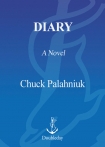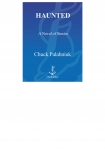Diary, Chuck Palahniuk [spicy books to read .TXT] 📗

- Author: Chuck Palahniuk
Book online «Diary, Chuck Palahniuk [spicy books to read .TXT] 📗». Author Chuck Palahniuk
Everything is a self-portrait.
Everything is a diary.
And the voice on the phone says, “Mrs. Wilmot?”
Vines scramble up the walls. Chimneys sprout from the slates on the roof.
And the voice on the phone says, “Misty?” The voice says, “Did you ever request the medical examiner's records for your husband's suicide attempt?” Detective Stilton says, “Do you know where your husband might have gotten sleeping pills?”
Just for the record, the problem with art school is that it can teach you technique and craft, but it can't give you talent. You can't buy inspiration. You can't reason your way to an epiphany. Develop a formula. A road map to enlightenment.
“Your husband's blood,” Stilton says, “was loaded with sodium phenobarbital.”
And there's no evidence of drugs at the scene, he says. No pill bottle or water. No record of Peter ever having a prescription.
Still painting, Misty asks where this is going.
And Stilton says, “You might think about who'd want to kill him.”
“Only me,” Misty says. Then she wishes she hadn't.
The picture is finished, perfect, beautiful. It's no place Misty's ever seen. Where it came from, she has no idea. Then, with a number 12 cat's-tongue brush full of ivory black, she wipes out everything in sight.
July 25
ALL THE HOUSES along Gum Street and Larch Street, they look so grand the first time you see them. All of them three or four stories tall with white columns, they all date from the last economic boom, eighty years ago. A century. House after house, they sit back among branching trees as big as green storm clouds, walnuts and oaks. They line Cedar Street, facing each other across rolled lawns. The first time you see them, they look so rich.
“Temple fronts,” Harrow Wilmot told Misty. Starting in about 1798, Americans built simple but massive Greek Revival façades. By 1824, he says, when William Strickland designed the Second Bank of the United States in Philadelphia, there was no going back. After that, houses large and small had to have a row of fluted columns and a looming pediment roof across the front.
People called them “end houses” because all this fancy detail was confined to one end. The rest of the house was plain.
That could describe almost any house on the island. All façade. Your first impression.
From the Capitol building in Washington, D.C., to the smallest cottage, what architects called “the Greek cancer” was everywhere.
“For architecture,” Harrow said, “it was the end of progress and the beginning of recycling.” He met Misty and Peter at the bus station in Long Beach and drove them down to the ferry.
The island houses, they're all so grand until you see how the paint's peeled and heaping around the base of each column. On the roof, the flashing is rusted and hangs off the edge in bent red strips. Brown cardboard patches windows where the glass is gone.
Shirtsleeves to shirtsleeves in three generations.
No investment is yours forever. Harry Wilmot told her that. The money was already running out.
“One generation makes the money,” Harrow told her once. “The next generation protects the money. The third runs out of it. People always forget what it takes to build a family fortune.”
Peter's scrawled words: “. . . your blood is our gold . . .”
Just for the record, while Misty drives to meet Detective Stilton, the whole three-hour drive to Peter's warehousing facility, she puts together everything she can remember about Harrow Wilmot.
The first time Misty saw Waytansea Island was while visiting with Peter, when his father drove them around in the old family Buick. All the cars in Waytansea were old, clean and polished, but their seats were patched with clear strapping tape so the stuffing stayed inside. The padded dashboard was cracked from too much sun. The chrome trim and the bumpers were spotted and pimpled with rust from the salt air. The paint colors were dull under a thin layer of white oxide.
Harrow had thick white hair combed into a crown over his forehead. His eyes were blue or gray. His teeth were more yellow than white. His chin and nose, sharp and jutting out. The rest of him, skinny, pale. Plain. You could smell his breath. An old island house with his own rotting interior.
“This car's ten years old,” he said. “That's a lifetime for a car at the shore.” He drove them down to the ferry and they waited at the dock, looking across the water at the dark green of the island. Peter and Misty, they were out of school for the summer, looking for jobs, dreaming of living in a city, any city. They'd talked about dropping out and moving to New York or Los Angeles. Waiting for the ferry, they said they might study art in Chicago or Seattle. Someplace they could each start a career. Misty remembers she had to slam her car door three times before it would stay shut.
This was the car where Peter tried to kill himself.
The car you tried to kill yourself in. Where you took those sleeping pills.
The same car she's driving now.
Stenciled down the side now, the bright yellow words say, “Bonner & Mills—When You're Ready to Stop Starting Over.”
What you don't understand you can make mean anything.
On the ferry that first day, Misty sat in the car while Harrow and Peter stood at the railing.
Harrow leaned close to Peter and said, “Are you sure she's the one?”
Leaned close to you. Father and son.
And Peter said, “I've seen her paintings. She's the real deal . . .”
Harrow raised his eyebrows, his corrugator muscle gathering the skin of his forehead into long wrinkles, and he said, “You know what this means.”
And Peter smiled, but only by lifting his levator labii, his sneer muscle, and he said, “Yeah, sure. Fucking lucky me.”
And his father nodded. He





Comments (0)